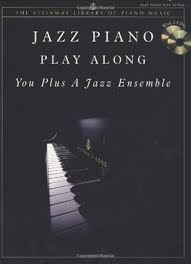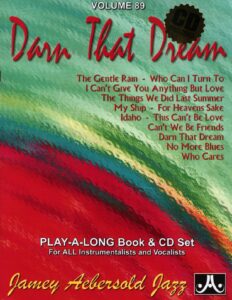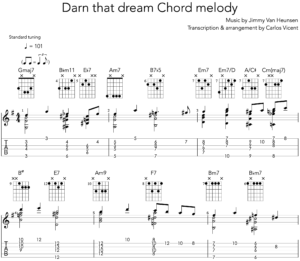Come join us now, and enjoy playing your beloved music and browse through great scores of every level and styles!
Can’t find the songbook you’re looking for? Please, email us at: sheetmusiclibrarypdf@gmail.com We’d like to help you!
Table of Contents
Darn that dream – (Easy Piano solo arr. & Guiar chords sheet music) – Jimmy Van Heusen

Darn that dream – Guitar chords and TABS sheet music
Best Sheet Music download from our Library.

Please, subscribe to our Library.
If you are already a subscriber, please, check our NEW SCORES’ page every month for new sheet music. THANK YOU!
“Darn That Dream”: A Jazz Standard Born from a Broadway Flop

“Darn That Dream”: A Jazz Standard Born from a Broadway Flop
Few songs embody the bittersweet ache of yearning quite like “Darn That Dream.” Though it emerged from the wreckage of a failed Broadway production, this Jimmy Van Heusen and Eddie DeLange composition transcended its origins to become one of the most beloved and frequently interpreted standards in the jazz canon, cherished for its sophisticated harmony and poignant lyricism.
Origin & Creators:
- Composer: Jimmy Van Heusen (born Edward Chester Babcock), one of the most prolific and successful composers of the Great American Songbook, known for melodies that were both sophisticated and accessible (“Swingin’ on a Star,” “Come Fly With Me,” “All the Way”).
- Lyricist: Eddie DeLange, a skilled lyricist who collaborated with many top composers (“Moonglow,” “Deep Purple,” “Solitude”).
- Debut: The song premiered in the 1939 Broadway musical revue “Swingin’ the Dream.” This ambitious, jazz-infused adaptation of Shakespeare’s A Midsummer Night’s Dream, set in 1890s New Orleans and featuring an all-star cast including Louis Armstrong, Benny Goodman, and Maxine Sullivan, was a notorious flop, closing after only 13 performances. Despite the show’s failure, “Darn That Dream” was its enduring legacy.
The Song Itself:
- Lyrics: DeLange’s words perfectly capture the frustration and lingering sweetness of an elusive, recurring dream about a loved one. Lines like “Darn that dream, I dream each night / You say you love me and you hold me tight” express the torment of waking to find the dream unrealized, yet the inability to let it go (“But darling, darn your eyes / Why should you want to see my tears? / Why should you haunt my reveries?”). It’s romantic yet tinged with melancholy and a touch of resentment.
- Form: Standard AABA structure (32 bars).
- Key & Harmony (The Jazz Magnet): Typically played in Eb Major.
- Verse: Often in the relative minor (C minor), setting a more pensive, searching mood before resolving to the major key for the chorus.
- Chorus (A Sections): Features a chromatically descending bass line (Eb – D – Db – C) under the main melody. This creates a series of rich, shifting harmonies. The chords over this descent often imply:
- Eb6 / | Dm7b5 / G7b9 / | Cm7 / F7 / | Bbm7 / Eb7 / | (or variations thereof like EbMaj7, D7#5#9, G7b9, etc.)
- Bridge (B Section): Modulates dramatically to the key of G Major, providing a bright, contrasting interlude before returning to the chromatic descent of the final A section. This harmonic shift is a hallmark and a challenge/opportunity for improvisers.
- Melody & “Licks”: The melody is elegant and somewhat wistful, often employing slight syncopations and leaning on the expressive potential of the underlying chromatic harmony. The chromatic descent in the bass naturally inspires improvisers to use corresponding chromatic passing tones, enclosures, and altered scales (like diminished or altered dominant scales) over the changing chords, especially over the D7#5#9/G7b9 type chords. The leap up on “Darn that dream” is iconic. Bill Evans’ introspective interpretations often featured delicate, harmonically dense right-hand lines weaving through the changes, while Miles Davis might focus on sparse, blues-inflected phrases emphasizing space and tone.
Artists Who Made It Shine (A Selection):
The song’s rich harmony made it catnip for jazz musicians:
- Benny Goodman & Mildred Bailey (1939): The first hit recording, featuring Bailey’s warm, intimate vocal, which topped the charts and rescued the song from obscurity.
- Bill Evans: His interpretations, both solo piano and in trios (notably on “Portrait in Jazz” and “Waltz for Debby”), are legendary. Evans delved deep into the harmony, creating lush reharmonizations and introspective explorations that redefined the song for many. He famously said, “It’s a flawed tune, but that’s what makes it interesting.”
- Miles Davis: Recorded memorable versions, including a standout track on the seminal “Birth of the Cool” sessions (1949/50), arranged by Gil Evans, showcasing a cool, understated approach. Also recorded it later with his quintet (e.g., “Miles Davis Quintet: The Legendary Prestige Quintet Sessions”).
- Chet Baker: His trumpet and vocal renditions perfectly captured the song’s romantic melancholy and vulnerability.
- Sarah Vaughan: Brought her incredible vocal range and harmonic sophistication to bear, creating powerful and nuanced versions.
- Ella Fitzgerald: Included definitive renditions in her Songbook series and live performances.
- Stan Getz: His lyrical tenor saxophone was ideally suited to the song’s mood.
- Keith Jarrett: Known for extended, deeply personal solo piano improvisations on the tune.
- Modern Interpreters: Countless artists continue to record and perform it, including Brad Mehldau, Diana Krall, Kurt Elling, and Wynton Marsalis.
Filmography:
- Swingin’ the Dream (1939): The original Broadway production (though no known film exists).
- Young Man with a Horn (1950): Featured in this fictionalized biopic about a jazz trumpeter (loosely based on Bix Beiderbecke), starring Kirk Douglas, Doris Day, and Lauren Bacall. Doris Day performs the song.
Why It Became a Jazz Standard:
- Harmonic Richness: The chromatic descent, modulations (verse to chorus, bridge), and potential for reharmonization provide endless fodder for improvisation and arrangement. It’s a “musician’s tune.”
- Emotional Depth: The lyrics express a complex mix of longing, frustration, and lingering affection that resonates deeply.
- Melodic Flexibility: The elegant melody provides a strong foundation that can be interpreted in countless ways – from ballad tenderness to more swinging or abstract approaches.
- Benny Goodman’s Hit: The initial popular recording ensured widespread familiarity.
- Embrace by Jazz Giants: Early and continued adoption by icons like Miles Davis, Bill Evans, Chet Baker, Ella Fitzgerald, and Sarah Vaughan cemented its status and demonstrated its potential within the jazz idiom. Their diverse interpretations proved its versatility.
- “Flawed” Beauty: As Bill Evans noted, its slightly unusual structure and harmonic quirks (like the dramatic bridge modulation) make it more interesting and challenging than a perfectly symmetrical tune, inviting creative solutions.
In Conclusion:
“Darn That Dream” is a testament to how artistic gold can emerge from unexpected places. Born in a Broadway failure, it found its true home in the world of jazz. Jimmy Van Heusen’s harmonically adventurous melody and Eddie DeLange’s yearning lyrics created a canvas perfectly suited for jazz exploration. Its unique blend of romantic melancholy and sophisticated chord changes has captivated generations of musicians and listeners, ensuring its place as an essential and enduring standard in the jazz repertoire. From Mildred Bailey’s first hit to Bill Evans’ profound meditations and beyond, the dream lives on, hauntingly beautiful and eternally relevant.

Browse in the Library:
Or browse in the categories menus & download the Library Catalog PDF:
